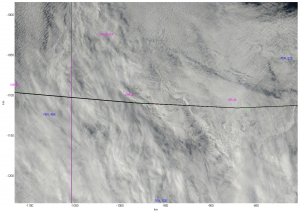15 July 2014, by Paul Johnston:
Life on the Oden has settled down to near normal. Many scientists are still preparing and checking things out. Hopefully today we will reach our first sampling station. When that happens, everyone will be busy, with science going on almost all the time. I’m writing this about 7:30 UT on 15 July. We are currently at 79.48 N, 122.1 E. We are still in an icy area, but there is also a lot of open water. For the past 2-3 days, we have been in major ice. There have been places where the ship has had to back track and go around thick, hard ice. Yesterday, I saw ice that was in the 2-3 m thickness range. When Oden goes through thick ice, the whole ship vibrates. There are occasional big bumps, but mostly it is like being on a train, with minor vibrations and rolling. There is some noise, but it is not extremely loud, again similar to riding a train. A couple of days ago, we saw snow. Last night, there was rain falling, and the radars could see a bright band a few hundred meters above the ship . (For those interested, when snow falls from high above the ground, when it reaches the freezing level it starts to melt. The melting snowflakes become very bright to radar signals, giving a region of enhanced reflectivity just below the freezing level. As the wet snow flakes fall more, they collapse into smaller drops that are not as strong a target.) This morning when I look at the radar, I can still see snow aloft, but it is not raining out. It is foggy this morning. There is a cloud cover most of the time. I saw the sun Sunday night as I was doing the 00Z radiosonde launch.

In the middle plot, Doppler Velocity, the Bright Band is the transition between slowly falling snow or ice crystals (yellow region) into the faster falling rain which are greater than 2.8 m/s and off the color scale shown on the right.

